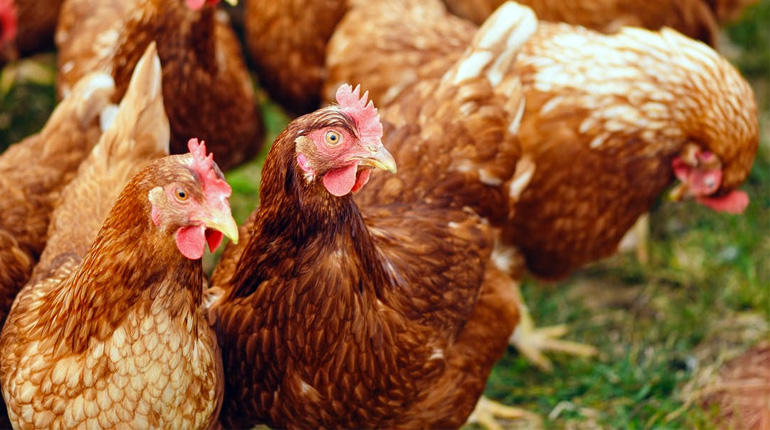Thirteen per cent of annual output from agriculture is from livestock and about US$60 million (K180 million) is made annually.
However, current cost of imported livestock products exceeds US$50 million (K150 million). Most meat and eggs are usually produced for local consumers. An estimated 60% of the output primarily from pigs and poultry never enter domestic trade but becomes available for domestic consumption. Despite the continued reliance on commercially grown meat, birds and eggs, home-grown broiler chickens are still popular among households in PNG. This is because of the high demand and low cost operation and availability of local resources. Current demand has outstripped supply and, thus, existing potential in the local market for dairy, meat, eggs and other animal products is quite high. By-products such as wool, skin and manure have evident potential in the local markets.
Increase in commercial poultry and pig production has occurred in the recent past and the country is virtually self-sufficient in these products. Local livestock farmers have enormous potential in managing their farm productivity. These can be possible through extension of market information and business skills in rural communities so as to enhance competitiveness of these farmers.
There is immense demand for meat and other livestock products but local production has grown slowly to meet this demand. However, production of livestock in PNG has been feeble. Efficient production and markets will improve through mechanisms such as proper market information, better infrastructure, appropriate research and technologies, high disposable income, better investment capital and improved storage and processing facilities. It is critical that human resource capacity be improved for value-added livestock processing as well.
These value added products can then be linked to niche markets. An effective marketing system is crucial for farm business success as markets require a product offer to a ready (existing) or potential customer base. The customer and product factor sits squarely in the centre and must be the pre-occupation of any business effort. Farm business management skill is a vital tool for entrepreneurship. Developing countries in Africa have invested a lot of resources in building capacity of the producers in terms of farm level quality assurance, process coordination and business skills.
Cooperatives were then formed to produce products competitively and for the niche markets. PNG has that potential and can tap into local resources and that can be assured through technology intervention, appropriate policies and Government participation. Support by private sectors can effectively drive agri-business through effective credit and extension and training systems. There are various tools and business skills that can be used for the development and planning of a farm enterprise.
Two basic business management tools that can be effectively applied by new (small) entrepreneurs are gross margins and partial budgets. Enterprise budget concept Small-scale (semi-subsistence) farmers have some degree of knowledge in bookkeeping and farm management. This budget concept gives a basic understanding of management of cash flow records and budgeting of livestock farm items.
Farm budgeting techniques can be applied to semi-subsistence farms where most products are disposed at the local market. This technique can be used to budget for animal feed from locally available options ranging from sweet potato, cassava, copra meal, bran millrun and fishmeal. Local feed sources such as cassava, sweet potato and other garden crops are cheaply available to farmers in the lowland and highland areas of Papua New Guinea. NARI and other stakeholders like NDAL, PDAL, industry partners and NGOs have been working to promote community awareness on promising livestock technologies.
Basic techniques in farming livestock, especially on feed, applied alongside these new crop varieties such as rice, sweet potato, yam and cassava can promote changes and bring prosperity.
Farm budgeting Gross margin budget is a tool that can be used to effectively evaluate farm profitability, efficiency and alternative decisions that may affect farm activities. Variable costs are deducted from overall income to give the gross margin. A model budget shows the level of gross income and the cost components. Gross income is the revenue received by multiplying the farm gate unit price with the amount of total production or output. The costs can also be divided into variable (those that vary with production; also called operating costs) and fixed (costs that will be incurred regardless of the level of production; also called ownership costs such as value of buildings, machinery and land). A positive gross margin contributes to paying fixed costs. Therefore, maximising profits is equivalent to maximising gross margin because fixed costs are constant.
Enterprise budgeting components Farmers can easily adjust by reducing or increasing their operation costs in the budget. This tool is very handy when making prompt decisions regarding allocation of resources. For instance, changing inputs such as access to water, pasture, feed and capital is necessary when increasing production or during low seasons.
To consider these marginal changes on the farm, a separate budget may be prepared for the overall profitability of a farm. This type of budget is referred to as a “partial budget”. Partial budgeting is a tool that can be effectively used when expanding an enterprise, selecting alternative enterprises, selecting different production practices, deciding to purchase equipment or hire, making a capital improvement, buying new equipment to replace manual labour or maintaining old equipment.
One or more of these effects may be related to cost and gross incomes. Decisions based on these changes will eliminate, reduce or add to costs and gross income. NARI’s role in livestock research and outreach activities has been targeting small rural farmers. Recent promotion of new technologies and information on breeding, development of nutritional diets for pigs, poultry and other livestock, production and animal husbandry and management skills can be provided to farmers. Model farm budgets can be prepared for low-cost feeding alternatives and for different livestock or crop systems.

